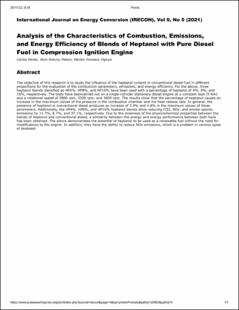Envíos recientes
-

Analysis of the characteristics of combustion, emissions, and energy efficiency of blends of heptanol with pure diesel fuel in compression ignition engine(Article)
...García, C.P | 2021-09
The objective of this research is to study the influence of the heptanol content in conventional diesel fuel in different proportions for the evaluation of the combustion parameters, emissions, and energy efficiency. For the above, three heptanol blends identified as HP4%, HP8%, and HP16% have been used with a percentage of heptanol of 4%, 8%, and 16%, respectively. The tests have beencarried out on a single-cylinder stationary diesel engine at a constant load (9 Nm) and a rotational speed of 2800 rpm, 3200 rpm, and 3600 rpm. The results show that the percentage of heptanol causes an increase in the maximum values of the pressure in the combustion chamber and the heat release rate. In general, the presence of heptanol in conventional diesel produces an increase of 3.9% and 4.8% in the maximum values of these parameters. Additionally, the HP4%, HP8%, and HP16% heptanol blends allow reducing CO2, NOx, and smoke opacity emissions by 11.7%, 6.7%, and 37.1%, respectively. Due to the closeness of the physicochemical properties between the blends of heptanol and conventional diesel, a similarity between the energy and exergy performance between both fuels has been obtained. The above demonstrates the potential of heptanol to be used as a renewable fuel without the need for modifications to the engine. In addition, they have the ability to reduce NOx emissions, which is a problem in various types of biodiesel.
LEER









